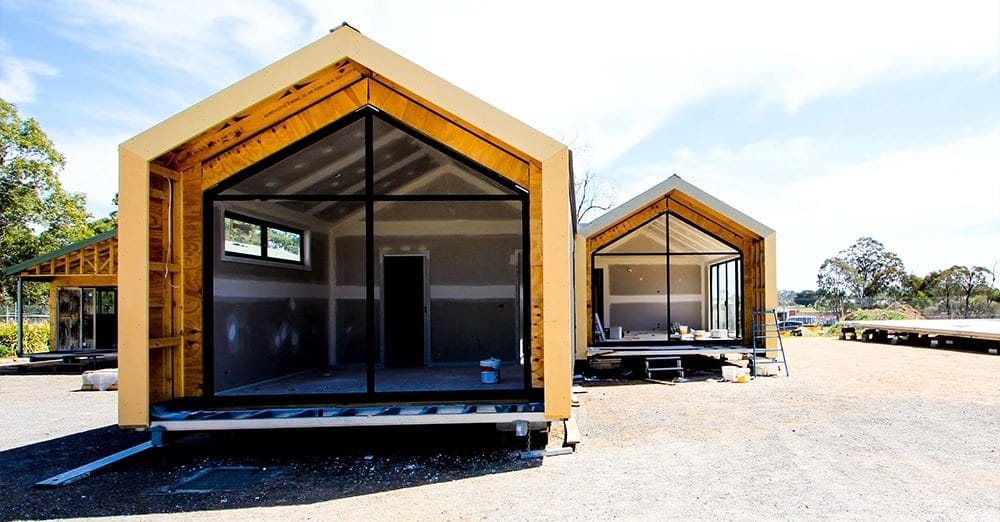Introduction: Why Prefab Construction Should Matter for Australia
Australia’s housing market feels like a pressure cooker. High demand, sluggish supply, skilled labour shortages, and planning bottlenecks all pile on the heat. Add rising construction costs and regulatory red tape, and it’s no wonder home buyers and builders alike feel stuck.
So, what’s the solution? Could prefab—or prefabricated construction—be the key to turning the tide?
A recent UK inquiry into construction sector capacity and prefab’s potential gives us plenty to think about. Their government’s ambition to build 1.5 million new homes is a moonshot. But while the UK grapples with planning delays, workforce gaps, and market jitters, Australia faces eerily similar challenges. What’s interesting is how prefab is pitched as a way to untangle the mess—offering faster build times, predictable costs, and potentially better quality. But can it live up to the hype?
This post isn’t about blue-sky dreaming. It’s about examining real-world issues and asking whether Australia can—and should—take a leaf out of the UK’s playbook.
Is prefab construction really our golden goose, or is it just another talking point?
Let’s cut through the noise with a cardboard knife and unpack what the UK’s findings mean for Aussie homeowners, builders, and regulators.
The Scale of the Challenge: Ambitions vs. Realities
The UK’s target to deliver 1.5 million homes during this Parliament is no small feat. It’s a bold goal, but it’s also a sobering reminder of just how challenging large-scale housing delivery can be. Australia faces its own uphill battle, from sky-high land costs to complex planning processes and a construction sector under pressure.
What stands out in the UK findings is the gap between political ambition and ground-level realities.
Hitting massive housing targets isn’t just about setting a number (housing target); it’s about overcoming entrenched challenges. Planning delays, unpredictable costs, and a lack of skilled workers all act as bottlenecks. Plus, the UK’s reliance on speculative house building—where developers hold off on building until market conditions look right—makes matters worse. Sound familiar?
In Australia, similar pressures play out. Targets to increase housing supply sound promising, but if planning approvals crawl and construction costs spike, those homes stay on paper.
The question isn’t just whether prefab can speed up building, but whether it can shift the whole system into gear.
Planning: The Choke point that Prefab Alone Can’t Solve
In the UK, planning delays are seen as one of the biggest hurdles to hitting housing targets. It’s not just red tape—it’s about complex approvals, unpredictable timelines, and stretched local authorities. Even when builders want to get moving, the system can slow everything to a crawl.
Australia’s planning system has its own set of challenges. Delays, council processes, and strict compliance requirements can add months—or even years—to projects.
Prefab construction might promise speed on the build site, but if approvals and consents aren’t streamlined, it’s like having a race car stuck at a red light.
Some voices in the UK inquiry highlighted that planning bottlenecks are often worsened by viability issues, infrastructure gaps, and the complexity of coordinating multiple agencies.
If we want prefab to really work in Australia:
- we need to rethink planning processes, integrate infrastructure planning, and create a system that’s less adversarial and more collaborative.
Skills and Workforce Gaps: Can Prefab Help?
The UK inquiry painted a clear picture: a construction sector struggling with skills shortages, an ageing workforce, and training systems that just aren’t keeping pace.
Sound familiar? Australia’s construction industry faces the same story:
—slow apprenticeship completion rates, SMEs struggling to find and keep skilled workers, and a training system with big leaks.
Prefab construction offers a different angle:
Factory-based methods could create more stable and predictable jobs. Instead of relying on casual labour and ad hoc training, we could move towards a system where workers are trained for specific prefab roles, with clearer career pathways.
It’s not a silver bullet, but it’s a shift in thinking.
However, the UK findings also warned that without proper planning and investment, prefab could simply shift the problem rather than solve it.
If we’re not careful, we’ll just end up with the same skills shortages—just in a different setting.
For Australia, that means aligning training, certification, and workforce planning to match the needs of a growing prefab sector.
Re-imagining the Workforce: Prefab Construction as a Haven for AI-Displaced Workers
As artificial intelligence (AI) continues to automate tasks across various industries, many workers find themselves facing job displacement. However, this challenge presents an opportunity: the construction sector, particularly prefab construction, can become a new frontier for these displaced workers.
What If We Don't Act?
If we fail to integrate AI-displaced workers into sectors like construction, we risk exacerbating unemployment and under utilising a skilled workforce. Conversely, by proactively channeling these individuals into prefab construction, we can address labor shortages and modernise the industry.
Why Prefab Construction?
Prefab construction involves assembling building components in a controlled factory environment before transporting them to the construction site. This method offers:
- Efficiency: Reduced construction time and costs.
- Quality Control: Enhanced precision and adherence to standards.
- Innovation: Integration of advanced technologies and processes.
These characteristics align well with the skill sets of workers from tech-driven industries, making prefab construction an ideal sector for their redeployment.
Leveraging Tech-Savvy Skills
Workers from sectors affected by AI, such as manufacturing and administrative roles, often possess skills in:
- Process Optimisation: Understanding and improving workflows.
- Quality Assurance: Ensuring products meet certain standards.
- Technical Proficiency: Operating and maintaining machinery.
These skills are transferable to prefab construction, where precision and efficiency are paramount.
Enhancing Construction Standards
Integrating AI-displaced workers into prefab construction can lead to:
- Improved Standards: Bringing a culture of continuous improvement and adherence to quality.
- Innovation: Introducing new technologies and methods to traditional construction practices.
- Workforce Diversity: Enriching the industry with varied experiences and perspectives.
A Vision for the Future
Imagine a housing market where purchasing a home is as seamless as ordering a product online:
- Customisation: Select design options tailored to individual preferences.
- Transparency: Receive regular updates on construction progress (wow, slow down)
- Quality Assurance: Benefit from rigorous inspections and standards (cause we have such a good industry reputation currently)
- Efficiency: Experience reduced construction times and costs.
By integrating AI-displaced workers into prefab construction, we move closer to this vision—transforming the housing industry into a more responsive and customer-centric sector. This shift moves us away from the current trend of “value engineering” materials and processes to maximise profit at the consumer’s expense.
If you want a glimpse of the future of residential housing in Australia, where major builders have consolidated into a few “mega builders,” look no further than the largest home builders in the USA. Some of their practices include:
- “You will hand over on this date, or we’ll cancel your contract and keep your progress claims.”
- “After you pay us, we’ll sort out what’s unfinished in the next few weeks.”
- “It’s built to ‘industry standard,’ and everyone else does it that way.”
Another emerging practice in residential construction in Australia is blaming defects on material performance—shifting the blame to suppliers when the real cause is poor design or site installation and quality control. This tactic makes the builder appear like a saviour in the eyes of the homeowner, as though they’re valiantly fighting “evil supplier corp” on their behalf.
In reality, it’s often not a product failure at all—whether it’s paint, plasterboard, or other materials. More commonly, the root cause lies in poor house design, a lack of building science integration into the house’s detailing or wall systems, or simply inadequate supervision and quality control. In many cases, builders and contractors fail to implement Inspection Test Plans (ITPs) or maintain proper quality management systems.
Financial and Market Barriers: Why Prefab Needs More Than a Factory
Prefab promises faster, more efficient builds—but even the slickest factory won’t deliver homes if no one’s willing to pay for them. The UK inquiry highlighted a tough reality: rising material costs, land prices, and market uncertainties make building harder, even with prefab. Without serious financial backing and clear, consistent policies, prefab factories risk sitting idle.
In Australia, we face similar issues: Rising interest rates, volatile material prices, and risk-averse investors are all dragging on housing delivery.
Even with prefab’s potential to lower construction time and labour costs, it’s not enough if the financial fundamentals aren’t there.
We need stronger incentives, public-private partnerships, and policies that de-risk investment in prefab housing.
The UK findings suggest that prefab’s success isn’t just about new technology—it’s about creating a financial ecosystem that supports innovation while delivering affordability.
If Australia doesn’t get this right, prefab could end up as a nice idea that never takes off.
Quality, Compliance, and Consumer Confidence
The UK inquiry didn’t just focus on how many homes get built—it zeroed in on how well they’re built. Poor quality, compliance failures, and low consumer trust have plagued traditional construction.
Prefab has the potential to lift standards, with factory-controlled environments and repeatable processes.
But only if backed by strong compliance systems and clear accountability.
Australia’s National Construction Code (NCC) sets minimum standards, but enforcement can be patchy, especially in residential construction. Homeowners often feel left in the dark when it comes to quality issues, with limited pathways for redress.
Prefab’s promise of higher quality will mean nothing if consumers aren’t confident their homes meet expectations and regulators aren’t equipped to enforce standards.
The UK’s push for a New Homes Ombudsman and stronger competency frameworks could inspire similar reforms here. Prefab alone won’t fix a system where poor oversight lets dodgy builders slip through the cracks.
But done right, it could raise the bar for everyone.
Modern Methods of Construction (MMC): Potential and Pitfalls
Prefab and modern methods of construction (MMC) sound great in theory—faster builds, better quality, and less waste. But the UK inquiry showed it’s not that simple. Councils and developers reported higher upfront costs, tricky logistics, and quality issues, especially at the interfaces between factory-built components and on-site work. Some even said, “We’ve been burned and won’t try it again.”
Australia’s prefab sector faces the same risks:
Without a clear, consistent demand pipeline and better integration with existing construction methods, prefab could struggle to scale.
High-profile failures, like L&G’s collapse in the UK, are warnings we can’t ignore.
That said, prefab isn’t a write-off. For niche applications—remote locations, challenging access sites, or high-density urban infill—it could be an industry game changer. And if the industry embraces modular standardisation, it could finally move from “buzzword” to “real-world solution.”
Policy and Industry Reforms: What Needs to Change?
The UK inquiry made one thing clear: prefab’s potential won’t be unlocked by technology alone. It’s going to take major reforms—planning systems that actually work, skills training aligned with industry needs, and financial frameworks that de-risk investment. For prefab to succeed, both government and industry need to step up and create an environment where innovation can thrive.
In Australia, we’ve seen the cracks in our planning and construction systems. Long approval times, inconsistent enforcement of standards, privatisation of critical functions, and a fragmented training ecosystem all stand in the way of real change.
If we want prefab to work here, we’ll need a unified approach: incentives for modular construction, streamlined approvals, smarter workforce planning, and tougher quality control.
This isn’t about replacing traditional construction—it’s about creating a more diverse, resilient housing sector that can adapt to changing demands.
The lesson from the UK? It’s time to stop talking and start acting.
Conclusion: Can Prefab Deliver for Australian Homeowners?
Prefab construction isn’t a silver bullet for Australia’s housing crisis, but it offers a serious opportunity to change the game. The UK inquiry revealed that while modern methods can improve speed and quality, they’ll only deliver results if we tackle systemic challenges—planning bottlenecks, workforce gaps, and shaky consumer confidence.
For prefab to succeed here, Australia needs a clear, consistent policy framework, investment in skills and training, and a stronger focus on compliance and quality. It’s not just about building more homes—it’s about building them smarter, faster, and better.
The question now is whether we’ll take those lessons seriously or keep patching over the cracks in a broken system. Prefab could help us catch up on housing demand, but only if we make the changes needed to let it thrive.
Further Reading




Frequently Asked Questions (FAQ's)
1. What is prefab housing?
Prefab housing refers to homes built in a factory or controlled environment, then transported and assembled on-site. It’s faster and can offer better quality control than traditional on-site construction.
2.How does prefab differ from traditional construction?
Prefab shifts much of the construction process into a factory, reducing on-site work. This can mean fewer delays from weather, less material waste, and more predictable build times.
3.What are the main barriers to prefab adoption in Australia?
Key challenges include planning delays, limited financial incentives, fragmented skills training, and inconsistent demand for prefab solutions. Without reform, prefab risks being an underused tool.
4.Could prefab reduce housing costs in the long run?
Potentially, yes. While initial costs can be higher, savings come from faster build times, reduced waste, and lower labour costs. But financial systems and consumer confidence need to support it.
5.How does prefab impact construction skills and training?
Prefab requires a shift from traditional trades to factory-based skills, creating more stable jobs and career paths. However, Australia’s training systems need updating to support this transition.
6.Are there Australian examples of successful prefab projects?
Yes, though they’re still relatively niche. Examples include modular housing for remote communities, high-density urban infill, and innovative social housing developments.
7.What changes are needed in planning regulations to support prefab?
Faster, clearer approvals, integration with infrastructure planning, and support for modular designs are essential. Without streamlined processes, prefab’s speed advantages won’t matter.
8.Does prefab compromise on quality compared to traditional methods?
Not if done right. Prefab can deliver superior quality through controlled factory conditions and repeatable processes, but strong compliance and oversight are critical.
9.How could prefab contribute to solving the housing crisis?
Prefab can deliver homes faster, improve quality, and create jobs, but it needs financial, regulatory, and training reforms to unlock its full potential.
10.What should homeowners consider when choosing prefab?
Homeowners should look at the builder’s track record, quality certifications, site compatibility, and after-sales support. Don’t assume faster build times mean cutting corners.





